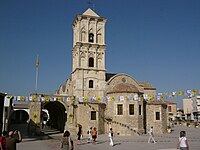Lazarus Church (Larnaka)
| Lazarus Church (Larnaka) Agios-Lazaros Ιερός Ναός Αγίου Λαζάρου |
|
|---|---|
| Patronage : | Lazarus of Bethany |
| Rank: | Main Church of Larnaka |
| Address: | Plateia Agiou Lazarou (Saint Lazarus Square), Larnaka |
Coordinates: 34 ° 54 ′ 41.3 " N , 33 ° 38 ′ 5.5" E
The Lazarus Church (Larnaka) (also Agios-Lazaros ) is a church in Larnaka , Cyprus, built in the late 9th century . It is located near the port and is a Greek Orthodox Church of the Autonomous Church of Cyprus , consecrated to Saint Lazarus of Bethany , who was bishop here for 30 years . It is one of the few Byzantine style multi-domed churches in Cyprus.
history
There is no evidence of an earlier church building at this point, but it can be assumed that this church was built on the site of an earlier cemetery, as evidenced by excavations.
The first church is likely to have had the shape of an early three-aisled Christian basilica , the tripartite division of the sacristy indicates that it was built not before the middle of the 6th century. This building may have been destroyed during the Arab rule (649-965).
Then a smaller church, again dedicated to St. Lazarus, was built on this site. This was even noticed in Constantinople . So sent (according to the Synaxarium of Constantinople - Codex Sirmondianus 12th - 13th centuries) the Byzantine emperor Leo VI. “The wise” sent a delegation to Larnaka to find this place of worship. A sarcophagus was discovered with the inscription "the fourth day of Lazarus and friend of Christ" which led to the conclusion that it was the shrine of St. Lazarus. As a thank you for giving (parts?) The bones of the saint, a larger church, today's church, was built here. The bones from the sarcophagus were brought to Constantinople, from where they were stolen by the Crusaders in 1204 and brought to Marseille . From there they went to the church of St. Lazare in Autun in Burgundy, where they are venerated today. This church is likely to have been built at the beginning of the 10th century and was probably subsidized by imperial funds, so that the complicated architectural design as a multi-domed church with three impressive domes was made possible. During the first years of Ottoman rule , the dome of this Orthodox basilica and the original bell tower were destroyed when the church was converted into a mosque.
In 1589 the church was bought back from the Ottomans for 3,000 Turkish silver coins, probably because of the Christian cemetery. For the next 200 years or so the church served as both an Orthodox and a Catholic church.
The precious Byzantine icons made by Chatzisavvas Taliadorou between 1773 and 1782 and the unique Baroque wood carving of the gold-plated iconostasis from 1793 to 1797 have been preserved to this day. Some wooden parts of the altar and marble parts of the pulpit also date from the 17th century and were used by the Catholics. After the Ottoman period, the church tower was built as a bell tower in the Latin style.
A fire caused severe damage in 1970, which destroyed large parts of the interior and was restored between 1972 and 1974. During this renovation, parts were identified in a sarcophagus under the altar that are attributed to St. Lazarus. Presumably not all relics were brought to Constantinople.
description
Today's three-aisled church is 31 m long and 20 m wide and is about 1.5 m below the level of the surrounding church square. The central nave is vaulted by three domes. Ancient Corinthian capitals , which were used as spoilers on the crossing pillars , and the iconostasis from the 18th century are the most important art objects of the church, along with an icon from the 17th century (it shows the resurrection of Lazarus). The access to the burial chamber with the skull of St. Lazarus is in the right area of the iconostasis. The church can be entered both from the rear and from the side via the side aisles via steps.
The bell tower from the 19th century is located southwest of the apse and is decorated with filigree stone carvings.
gallery
Web links
- Official website: http://www.ayioslazaros.org/index.html
- Information on larnakaregion.com read on July 6, 2012
- Lazarus Church on visitcyprus.com Information on visitcyprus.com - read on July 6, 2012
literature
- Baedeker Allianz Travel Guide Cyprus , 6th edition 2001, ISBN 3-87504-419-3 , p. 154.






